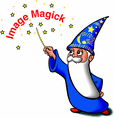
 Display Display |
-
Display is a machine architecture independent
image processing and display program. It can display an image on any workstation
display running an X server. The image can be displayed as background
image of any window.
-
Display first determines the hardware capabilities of your workstation.
If the number of unique colors in an image is less than or equal to the
number the workstation can support, the image is displayed in an X window.
Otherwise the number of colors in the image is first reduced to match the
color resolution of the workstation before it is displayed.
-
This means that a continuous-tone 24 bits/pixel image can display on a
8 bit pseudo-color device or monochrome device. In most instances the reduced
color image closely resembles the original. Alternatively, a monochrome
or pseudo-color image sequence can display on a continuous-tone 24 bits/pixels
device.
 Import Import |
-
Import reads an image from any visible window
on an X server and outputs it as an image file. You can capture
a single window, the entire screen, or any rectangular portion of the screen.
You can use the display utility for redisplay, printing, editing,
formatting, archiving, image processing, etc. of the captured image.
-
The target window can be specified by id, name, or may be selected by clicking
the mouse in the desired window. If you press a button and then drag, a
rectangle will form which expands and contracts as the mouse moves. To
save the portion of the screen defined by the rectangle, just release the
button. The keyboard bell is rung once at the beginning of the screen capture
and twice when it completes.
 Animate Animate |
-
Animate displays a sequence of images on any
workstation display running an X server. Animate first determines
the hardware capabilities of the workstation. If the number of unique colors
in an image is less than or equal to the number the workstation can support,
the image is displayed in an X window. Otherwise the number of colors
in the image is first reduced to match the color resolution of the workstation
before it is displayed.
This means that a continuous-tone 24 bits/pixel image can display on
a 8 bit pseudo-color device or monochrome device. In most instances the
reduced color image closely resembles the original. Alternatively, a monochrome
or pseudo-color image sequence can display on a continuous-tone 24 bits/pixels
device.
 Montage Montage |
-
Montage creates a composite by combining several
separate images. The images are tiled on the composite image with the name
of the image optionally appearing just below the individual tile.
 Convert Convert |
-
Convert converts an input file using one image
format to an output file with a differing image format. By default, the
image format is determined by its magic number. To specify a particular
image format, precede the filename with an image format name and a colon
(i.e. ps:image) or specify the image type as the filename suffix
(i.e. image.ps). Specify file as - for standard input or output.
If file has the extension .Z, the file is decoded with uncompress.
 Mogrify Mogrify |
-
Mogrify transforms an image or a sequence of
images. These transforms include image scaling, image rotation,
color
reduction, and others. The transmogrified image
overwrites the
original image.
 Identify Identify |
-
Identify describes the format and characteristics
of one or more image files. It will also report if an image is incomplete
or corrupt. The information displayed includes the scene number, the file
name, the width and height of the image, whether the image is colormapped
or not, the number of colors in the image, the number of bytes in the image,
the format of the image (JPEG, PNM, etc.), and finally the number of seconds
it took to read and process the image.
 Composite Composite |
-
Composite composites images to create new images.
 Conjure Conjure |
-
Conjure interprets and executes scripts in
the Magick Scripting Language (MSL).
-
The Magick scripting language (MSL) will primarily
benefit those that want to accomplish custom image processing tasks but
do not wish to program, or those that do not have access to a Perl
interpreter or a compiler. The interpreter is called conjure and here
is an example script:
<?xml version="1.0" encoding="UTF-8"?>
<image size="400x400" >
<read filename="image.gif" />
<get width="base-width" height="base-height" />
<resize geometry="%[dimensions]" />
<get width="width" height="height" />
<print output=
"Image sized from %[base-width]x%[base-height]
to %[width]x%[height].\n" />
<write filename="image.png" />
</image>
-
invoked with
conjure -dimensions 400x400 incantation.msl
-
All operations will closely follow the key/value pairs defined in
PerlMagick, unless otherwise noted.
 Image manipulation software that works like magic.
Image manipulation software that works like magic.

